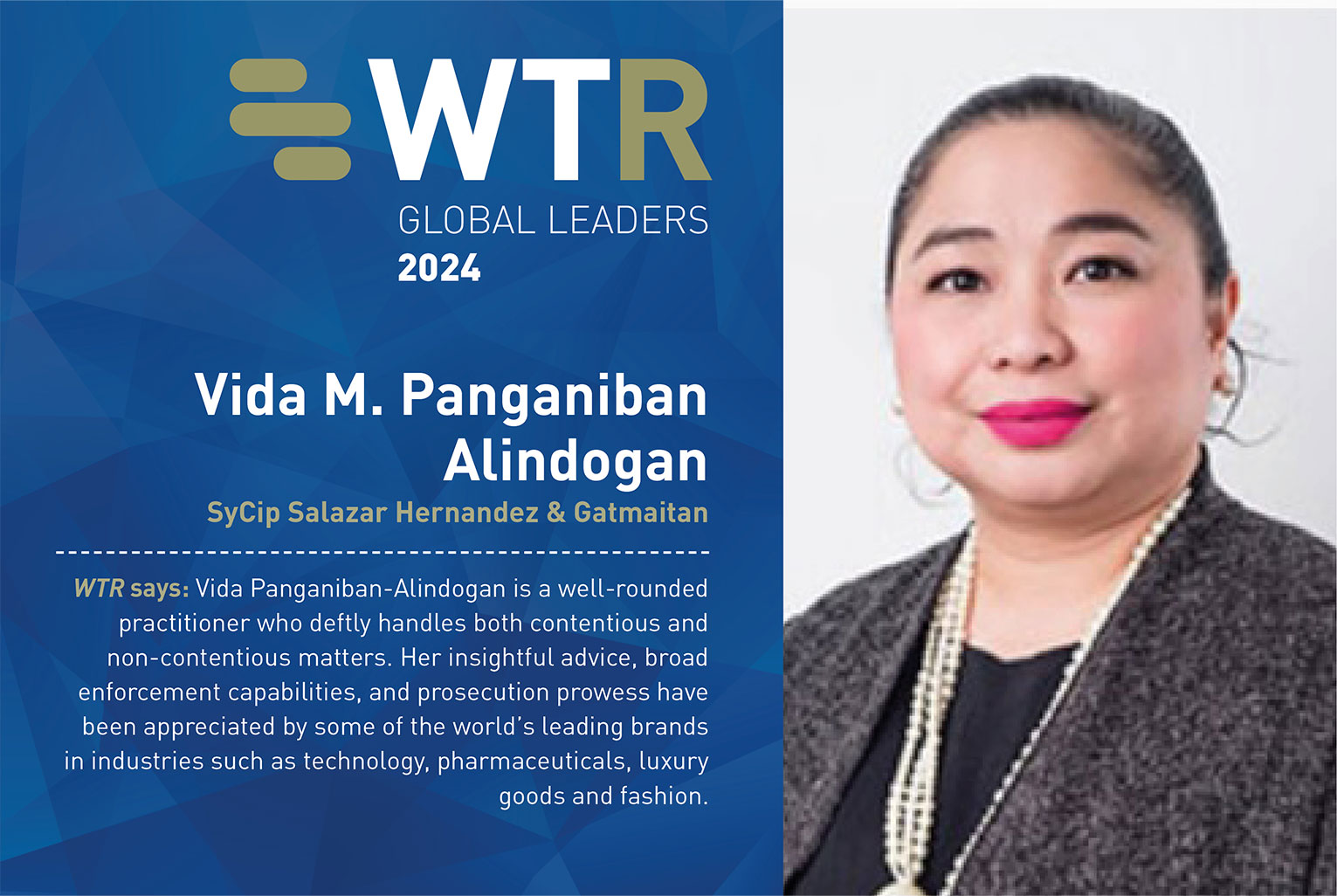Vida M Panganiban-Alindogan
What inspired you to pursue a career in intellectual property, and what advice would you give to others considering a similar path?
If I recall correctly, it was Benjamin Franklin who said that in life, nothing is certain except death and taxes. I propose adding intellectual property to that list. Almost everything we have, use, touch or eat involves some form of intellectual property – from the clothes we wear and the toothpaste we use to the movies we watch or the music we listen to. It cannot be denied that intellectual property has a significant impact on our lives and is an invaluable asset for individuals, businesses and society as a whole.
The IP landscape is dynamic and constantly evolving. It is therefore vital for IP practitioners to learn to adapt to this environment of innovation and creativity. Learning is nonstop.
Counterfeiting continues to rise around the world. What are your top tips for taking counterfeiters to court – and why is it an effective strategy?
Preparation prior to any action is crucial. It is important to carefully evaluate your case not just at the beginning but throughout the process, so that strategies, resources and expectations are properly managed.
A comprehensive business solution is also essential. IP protection should be an integral part of any business culture. A greater level of awareness of the importance and value of intellectual property is a key factor in identifying risks and solutions.
What recent decisions or legislative developments are having the biggest impact on trademark strategy in the Philippines right now?
In an en banc decision in Kolin Electronics v Kolin Philippines International, the Supreme Court of the Philippines laid down a landmark ruling when it categorically abandoned the holistic test as a tool to determine likelihood of confusion between similar and competing trademarks (GR 228165). In doing so, the court noted that only the dominancy test is incorporated in the IP Code, particularly Section 155(1), which defines trademark infringement as the “colorable imitation of a registered mark… or a dominant feature thereof”. Therefore, it is the dominancy test that should be used to determine the resemblance between competing marks.
The Supreme Court also came up with a multifactor test to determine likelihood of confusion, which includes:
- the strength of the plaintiff’s mark;
- the degree of similarity between the plaintiff’s and the defendant’s marks;
- similarity of the products or services;
- likelihood that the plaintiff will bridge the gap;
- evidence of actual confusion;
- the defendant’s good faith in adopting the mark;
- the quality of the defendant’s product or service; and
- the sophistication of the buyers.
The Supreme Court also ruled in this case that knowledge of the another’s ownership of a mark at the time of filing constitutes bad faith.
You work with many international clients from a wide range of industries – from fashion and luxury brands to tech and pharmaceutical companies. How do you adapt your approach depending on the type of client that you are dealing with?
Familiarity with the relevant industry that the client belongs to is key when developing a strategy. Before interacting with a client, it is helpful to study and research their industry, business model, pain points and goals. This will provide you with an insight and understanding that will help you to tailor your approach and proposals to meet the client’s unique requirements.
It is equally important to be flexible and adaptable in your interactions with clients. You must be prepared to shift your approach based on their feedback, preferences and changing circumstances. An open and effective line of communication is vital.
What steps is your firm taking to improve hiring processes to increase DEI in the workplace, and what could the IP industry as a whole be doing to address this?
The firm constantly reviews and evaluates our hiring processes to identify areas for improvement, and we adjust as needed to foster a more diverse, equitable and inclusive workplace. The IP industry could provide more training and educational programmes to raise awareness about DEI issues and promote a culture of inclusivity within the industry.
Vida M Panganiban-Alindogan
Partner
[email protected]
Leading IP lawyer Vida M Panganiban-Alindogan heads the firm’s IP department. Ms Panganiban-Alindogan advises and provides services to a diverse international clientele, including well-known fashion and apparel brands, luxury goods companies, technology businesses and pharmaceutical companies. She currently serves as president of LES Philippines and is on the board of trustees for the Intellectual Property Association of the Philippines. She is a member of the Asian Patent Attorneys Association and Integrated Bar of the Philippines.
